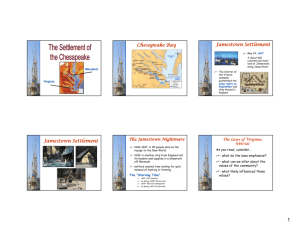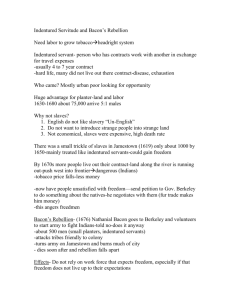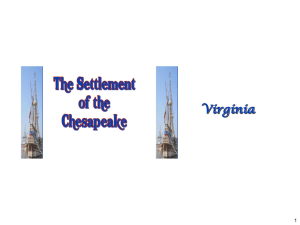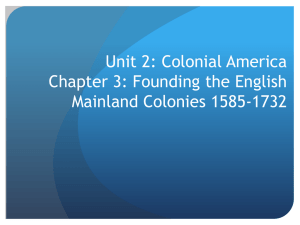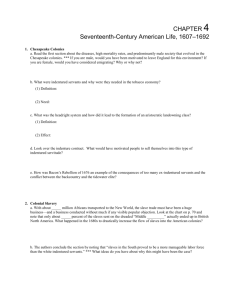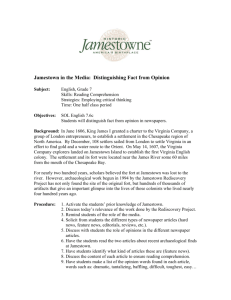Chesapeake Colonization
advertisement
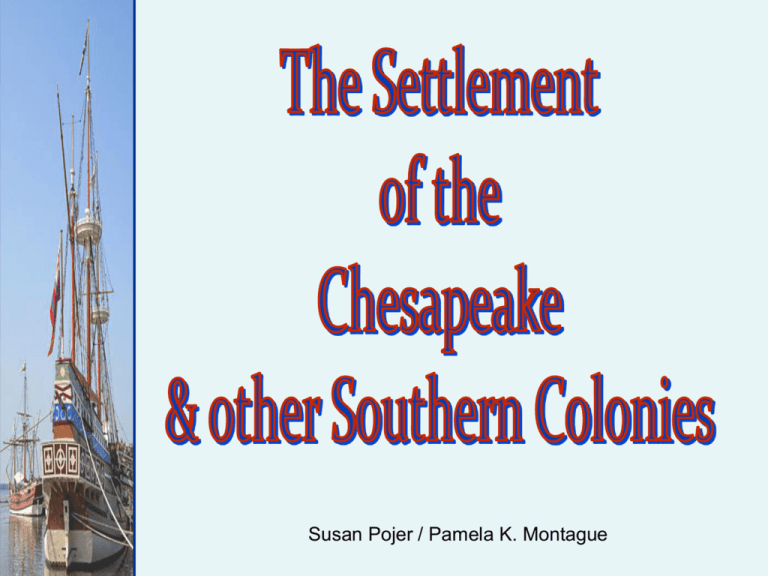
Susan Pojer / Pamela K. Montague The Planting of English America Spain’s European Rivals: • English – John Cabot, 1497 – Newfoundland, NE coast N.Am. • French – Verrazano, 1524, Carolina up to Nova Scotia – Cartier, 1534 – St. Lawrence River • BUT, neither French or English are serious rivals in beginning, why? – Too much internal conflict; Protestant Reformation – Intense rivalry soon develops though between Catholic Spain and Protestant England • By 17th century, each power has major outpost in North America – Spanish – Santa Fe, 1610 – French – Quebec, 1608 – English – Jamestown, 1607 English Colonization Elizabeth I Takes the throne in 1588 & rivalry with Spain intensifies Crushes the Irish mercilessly – Protestant landlords Too weak to break Spanish monopoly in New World so… Encourages plunder of Spanish ships and raiding of Spanish settlements; DRAKE Attempts a settlement at Newfoundland – Sir Humphrey Gilbert / unsuccessful How did the laws of primogeniture encourage English exploration? English Colonization Virginia § Sir Walter Raleigh to VA in 1585 § Establishes Roanoke – known as the “Lost Colony” – WHY? Who is Virginia Dare? § What delayed the English supply ship headed to Roanoke in 1588? § attack of the Spanish Armada § England defeats Spain & finally breaks SP monopoly in New World § Effects of Defeat of the SP Armada: § Strong sense of nationalism…Shakespeare § Gov’t support of colonization § Strong, popular monarch & religious unity § Set England on path to world dominance English Colonization Virginia The Charter of the Virginia Company of London, 1606: § Guaranteed to colonists the same rights as Englishmen as if they had stayed in England – will be incorporated into future colonial documents. § Colonists felt that, even in the Americas, they had the rights of Englishmen! England Plants the Jamestown “Seedling” Late 1606 VA Co. sends out 3 ships Purpose of expedition? Spring 1607 land at mouth of Chesapeake Bay. § Attacked by Indians and move on up the bay. May 24, 1607 approx. 144 colonists [all men] land at Jamestown, along banks of James River § Easily defended, but swarming with disease-causing mosquitoes. Jamestown Settlement, 1607 The Godspeed, Discovery, and Susan Constant Chesapeake Bay Geographic/environmental Jamestown Fort & Settlement Map Jamestown Fort & Settlement Jamestown Housing Jamestown Settlement Jamestown Chapel, 1611 Continuing Discovery at Jamestown The Jamestown Nightmare 1606-1607 - 40 people died on the voyage to the New World. 1609 - another ship from England lost its leaders and supplies in a shipwreck off Bermuda. Settlers died from disease, malnutrition, starvation – only 60 of 400 survive “starving time” winter 1609-1610 …why? Early“Gentlemen” colonists would not work § Game in forests & fish in river uncaught. § Wasted time looking for gold instead § Merchant directors – ineffective guidance Captain John Smith: The Right Man for the Job?? Took over in 1608 Becomes expert forager & Indian trader Asks London Co. for farmers, carpenters, masons, etc. Stays in colony only 2 years, but it would have perished without him There was no talk…but dig gold, wash gold, refine gold, load gold… Pocahontas Pocahontas “saves” Captain John Smith What actually happened? Four Faces of Pocahontas Chief Powhatan Powhatan Confederacy Powhatan dominated a few dozen small tribes in the James River area when the English arrived. The English called all Indians in the area Powhatans. Powhatan probably saw the English as allies in his struggles to control other Indian tribes in the region. Powhatan Confederacy Powhatan Indian Village Indian Foods Smith’s Portrayal of Native Americans Interpretation? Culture Clash in the Chesapeake Relations between Indians & settlers grew worse – why? General mistrust because of different cultures & languages. English raided Indian food supplies during the starving times. 1610-1614 First Anglo-Powhatan War De La Warr (came in 1610) had orders to make war on the Indians. Raided villages, burned houses, took supplies, burned cornfields. Culture Clash in the Chesapeake 1614-1622 peace between Powhatans and the English. 1614 peace sealed by the marriage of Pocahontas to Englishman John Rolfe. Powhatan Uprising of 1622 1622-1644 periodic attacks between Indians and settlers. 1622 Indians attacked the English, killing 347 [including John Rolfe]. Virginia Co. called for a “perpetual war” against the Native Americans. Raids reduced native population and drove them further westward. Culture Clash in the Chesapeake 1644-1646 Second AngloPowhatan War Last effort of natives to defeat English. Indians defeated again. Powhatans suffered from 3 D’s – meaning? Peace Treaty of 1646 Removed the Powhatans from their original land. Formally separated Indian and English settlement areas (origins of reservations). John Rolfe What finally made the colony prosperous?? Tobacco Plant Virginia’s gold and silver. -- John Rolfe, 1612 Early Colonial Tobacco 1618 — Virginia produces 20,000 pounds of tobacco. 1622 — Despite losing nearly one-third of its colonists in an Indian attack, Virginia produces 60,000 pounds of tobacco. 1627 — Virginia produces 500,000 pounds of tobacco. 1629 — Virginia produces 1,500,000 pounds of tobacco. Virginia: “Child of Tobacco” Tobacco’s effect on Virginia’s economy: Vital role in putting VA on a firm economic footing. Ruinous to soil when continuously planted – leads to continuous desire for LAND! Chained VA’s economy to a single crop. Promoted headright system Tobacco promoted the use of the plantation system. Need for cheap, abundant labor. Why was 1619 a pivotal year for the Chesapeake settlement? First Africans arrived in Jamestown in 1619. Their status was not clear perhaps slaves, perhaps indentured servants. Slavery not that important until the end of the 17c. And… Virginia House of Burgesses Growing Political Power The House of Burgesses established in 1619 – 1st representative form of gov’t in America began to assume the role of the House of Commons in England Control over finances, militia, etc. By the end of the 17c, H of B was able to initiate legislation. A Council appointed by royal governor Mainly leading planters. Functions like House of Lords. High death rates ensured rapid turnover of members. Virginia Becomes a Royal Colony James I grew hostile to Virginia He hated tobacco. He distrusted the House of Burgesses which he called a seminary of sedition. What is “sedition?” 1624 he revoked the charter of the bankrupt VA Company. Thus, VA became a royal colony, under the King’s direct control. Indentured Servitude Origins Indenture Marks The term indentured servant derives its name from the indenture, or mark on two copies of the contract the master and the servant signed. To prevent one of the parties from trying to alter the contract, the two copies of the contract were laid on top of one other, and identical marks were made. This contract has been marked, but not yet indentured. If anyone questioned the contract, the two pieces of paper would be placed on top of one other to try match the marks. This contract has been indentured. Indentured Servitude Headright System – who benefitted? Each Virginian got 50 acres for each laborer whose passage he paid. System used in MD also. 100,000 in VA/MD by 1700 – cheaper than slaves Indenture Contract – general terms? Mostly young men, 15-25 4 years (skilled) -7 years (unskilled) Promised “freedom dues” [land, £, clothing, two hoes, three barrels of corn, and fifty acres of land] Forbidden to marry; no travel without permission. 1610-1614: only 1 in 10 outlived their indentured contracts! Frustrated Freemen Majority of VA settlers came as indentured servants By late 1600s large numbers of young, poor, discontented men in the Chesapeake area. Little access to land or women for marriage. 1670 The Virginia Assembly disenfranchised most landless men. Meaning? Nathaniel Bacon’s Rebellion: 1676 Led 1,000 Virginians in a rebellion against Governor Berkeley Nathaniel Bacon Governor William Berkeley Rebels resented Berkeley’s close relations with Indians. Berkeley monopolized the fur trade with the Indians in the area. Berkley refused to retaliate for Indian attacks on frontier settlements. Bacon’s Rebellion: 1676 Bacon’s Rebellion Rebels attacked Indians, whether they were friendly or not to whites. Governor Berkeley driven from Jamestown. Rebels burned the capital and then went on a rampage of plundering. Bacon died suddenly of fever. Berkeley brutally crushed the rebellion and hanged 20 rebels. Results of Bacon’s Rebellion It exposed resentments between inland frontiersmen and landless former servants against gentry on coastal plantations. (East-West Conflict) Socio-economic class differences/clashes between rural and urban communities which will continue throughout American history. Upper class planters searched for laborers less likely to rebel BLACK SLAVES!! Colonial Slavery Beginning in 1662 “Slave Codes” Made blacks [and their children] chattel (property) for the lifetime of white masters. In some colonies, it was a crime to teach a slave to read or write. Conversion to Christianity did not qualify the slave for freedom. Reasons for switch from Servants to Slaves: Bacon’s rebellion – planters fearful of mutinous former servants Rising wages in England led to less willing to gamble on indentured servitude Royal African Company loses monopoly on carrying slaves to colonies (RI becomes big slave trader). Servants wanted land – no one would want to give land to black slaves. The Atlantic Slave Trade The “Middle Passage” Barbaric conditions, at least 20% died during this passage. Colonial Slavery As the number of slaves increased, white colonists reacted to put down a perceived racial threat. Slavery transformed from economic to economic and racial institution. Early 1600s differences between slave and servant were unclear. By the mid-1680s, black slaves outnumbered white indentured servants and slave codes are entrenched. Slave Revolts Stono Revolt – 1730, SC Over 50 slaves meet at Stono River & begin march to Spanish Florida. Stole guns & ammo from store at Stono Bridge & killed 2 storekeepers Burned 7 plantations & killed 20 whites – number grows to 80 slaves Militia comes after them – 44 slaves, 20 whites killed in putting down rebellion Captured slaves decapitated – heads spiked on mile posts to Charleston. BUT, no slave rebellion ever equals the scale of the rebellion of former servants such as those in Bacon’s Rebellion. The Settlement of Maryland A royal charter was granted to George Calvert, Lord Baltimore, in 1632. A proprietary colony created in 1634. A healthier location than Jamestown. Tobacco would be the main crop. Why a “poor man’s crop?” His plan was to govern as an absentee proprietor in a feudal relationship. Huge tracts of land granted to his Catholic relatives. Colonization of Maryland St Mary’s City (1634) A Haven for Catholics Supposed to be a haven for Catholics but, the irony is ….? Colonists were only willing to come to MD if they received land. Colonists who did come received modest farms dispersed around the Chesapeake area. Catholic land barons surrounded by mostly Protestant small farmers. Conflict between barons and farmers led to Baltimore losing proprietary rights at the end of the 17c. In the late 1600s, black slaves began to be imported. A Haven for Catholics Baltimore permitted high degree of freedom of worship in order to prevent repeat of persecution of Catholics by Protestants. High number of Protestants threatened because of overwhelming rights given to Catholics. Toleration Act of 1649 Supported by the Catholics in MD. Guaranteed toleration to all CHRISTIANS. Decreed death to those who denied the divinity of Jesus [like Jews, atheists, etc.]. In one way, it was less tolerant than before the law was passed!! Settling the Lower South The Carolinas • Named after Charles II • Held by 8 proprietors with wide authority • Charleston established 1680 – busiest seaport in U.S. & only seaport in the South Crops of the Carolinas Rice Indigo Rice & Indigo Exports from SC & GA: 1698-1775 The Carolinas • Eventually splits in 1712 & both become royal colonies: – NC – poorer region – independent! – SC – prosperous - aristocratic • North Carolina: – Settled by poverty-stricken outcasts & religious dissenters from VA – Strong spirit of resistance to authority – Hospitable to pirates – Democratic / Independent / NON-aristocratic – “A vale of humility between 2 mountains of conceit.” South Carolina • Strong ties with West Indies sugar islands – many settlers from there • Adopted its slave code – Barbados Code • RICE becomes major crop • Set up strong slave trade – Sell over 10,000 Indian slaves to sugar islands • West African slaves become predominant labor source … WHY? – Had experience with rice – Immune to malaria – Become majority of the population by 1710! Georgia The Last English Colony Founded by James Oglethorpe & other London philanthropists, 1733 – Took honest persons imprisoned for debts to resettle there • English want buffer from SP Florida so charter granted • Oglethorpe has idealistic regulations: – No more than 50 acres land – non-transferable – No rum – to ensure sobriety – No slaves – to ensure hard work • Founders disillusioned by 1752 – becomes royal colony • Settlers began migration into “back-country” Southern Society • Primary religious affiliation? – Anglican church • Highly illiterate – not much formal schooling – why? • Slavery in all colonies • Aristocratic atmosphere (except NC!); wealthy planters have the power • Rigid social class structure: – Wealthy planters – Small Farmers (with slaves / without slaves) – Landless whites – Slaves River Settlement Pattern in the South Large plantations [>100 acres]; Widely spread apart [>5 miles] – Impact? Leads to few large cities; mostly rural; churches & schools difficult to establish Waterways are the main “roads” High Mortality Rates Adult life expectancy: 40 years Death of children before age 5: 80% Not many children have grandparents SOUTHERN SOCIETY “Widowarchy” High mortality among husbands and fathers left many women in the Chesapeake colonies with unusual autonomy and wealth compared to women in other colonial regions.


